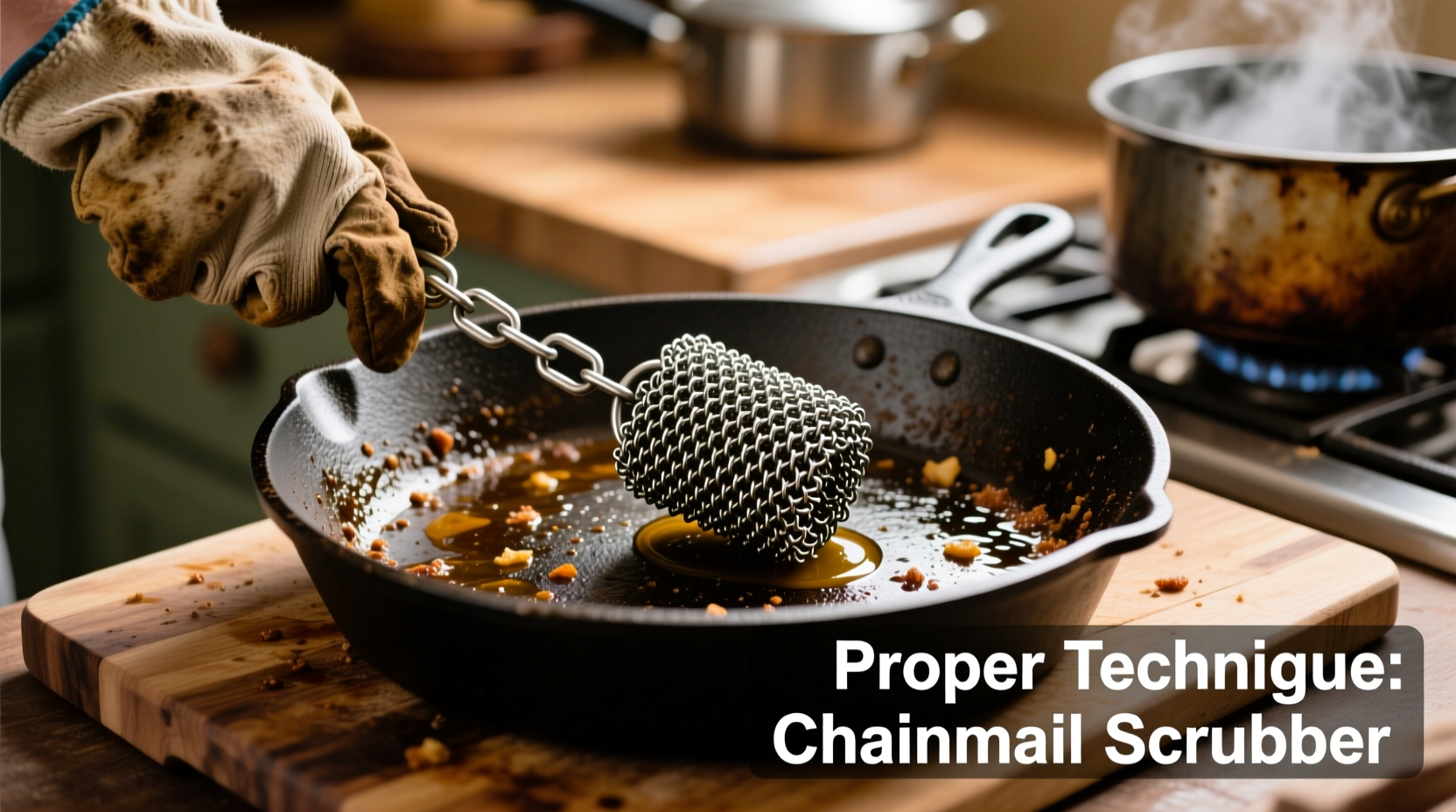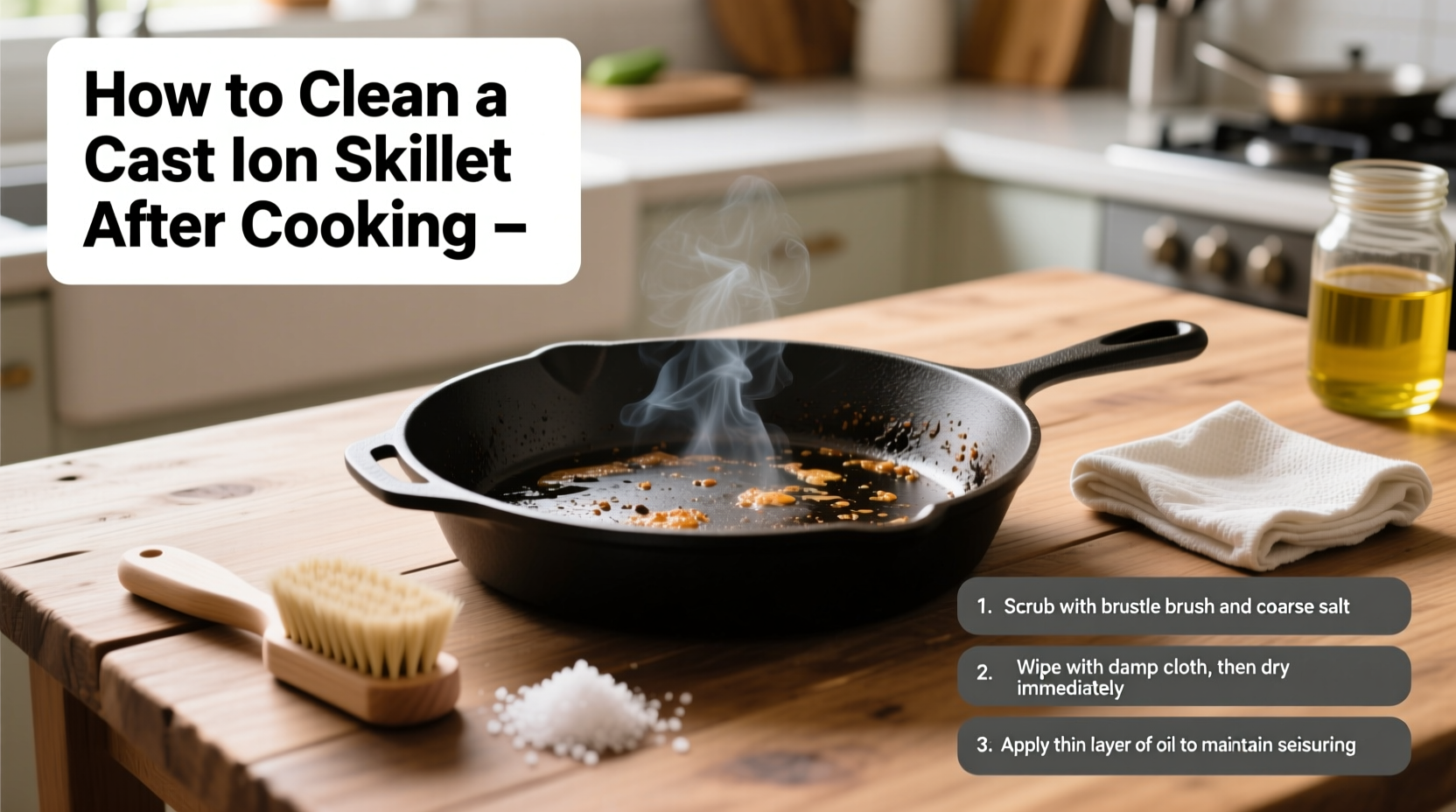Proper cast iron skillet maintenance isn't complicated, but it does require understanding the science behind seasoning preservation. Many home cooks make critical mistakes that strip away years of built-up seasoning or invite rust. Let's walk through the exact process professional chefs use to keep their cast iron in perfect condition after every use.
Why Proper Cleaning Preserves Your Skillet's Performance
Cast iron's non-stick surface comes from polymerized oil layers known as seasoning. When cleaned improperly, this protective layer breaks down, leading to food sticking and potential rust formation. The University of Illinois Extension confirms that maintaining proper seasoning through correct cleaning extends cast iron cookware lifespan significantly.
| Proper Cleaning Approach | Improper Cleaning Method | Result After 6 Months |
|---|---|---|
| Wipe while warm, minimal water, thorough drying | Soaking in water for extended periods | Smooth, dark seasoning; excellent non-stick performance |
| Light scrubbing with chainmail or brush | Aggressive steel wool or dishwasher use | Metal showing through; food sticks frequently |
| Thin oil layer after drying | Storing while damp or without oil | Rust spots requiring re-seasoning |
The Step-by-Step Cleaning Process You Should Follow
Step 1: Cool to the Right Temperature
Never clean your cast iron while piping hot or completely cold. Wait until it's warm to the touch (about 5-10 minutes after cooking). Cleaning while too hot risks warping; cleaning when cold makes food residue harder to remove. This temperature sweet spot allows for effective cleaning without damaging the metal.
Step 2: Remove Food Residue Immediately
While your skillet is still warm, use a paper towel or soft cloth to wipe away excess oil and food particles. For most cooking tasks, this simple step removes 80-90% of residue. Don't skip this critical step—allowing food to cool completely makes cleaning much harder later.
Step 3: Address Stubborn Bits Without Damaging Seasoning
For stuck-on food:
- Fill the skillet with a small amount of hot water and place back on burner for 1-2 minutes
- Use a chainmail scrubber or stiff brush (never steel wool)
- For particularly stubborn spots, sprinkle coarse salt as a gentle abrasive
According to Lodge Manufacturing's care guide, modern cast iron can handle minimal soap if thoroughly rinsed and dried immediately after, contrary to old myths.

Step 4: The Critical Drying Process
This is where most people fail. After rinsing:
- Wipe with a dry towel
- Place on stovetop over medium-low heat for 3-5 minutes
- Check for any remaining moisture by looking for steam
- Continue heating until completely dry and warm to touch
Rust forms when moisture sits on the metal surface, so this heating step is non-negotiable for long-term skillet health.
Step 5: Oil Application Technique
While your skillet is still warm from drying:
- Apply 1/4 teaspoon of high-smoke point oil (grapeseed, canola, or flaxseed)
- Use a paper towel to spread a microscopically thin layer
- Wipe away excess until the surface looks almost dry
Too much oil creates a sticky residue; too little leaves the surface vulnerable. The perfect amount creates an invisible protective layer.
Troubleshooting Common Cast Iron Cleaning Problems
When Food Is Stuck After Cooking
If you neglected immediate cleaning and food has cooled:
- Add 1/4 cup water and bring to a simmer for 2-3 minutes
- Use a wooden spatula to gently loosen residue
- Proceed with standard cleaning steps
Never use metal utensils on cooled stuck food as this damages seasoning.
Dealing with Rust Spots
If you notice rust despite proper care:
- Scrub affected area with steel wool or vinegar solution
- Rinse thoroughly and dry completely
- Apply oil and heat in oven at 375°F for 1 hour
- Repeat seasoning process 2-3 times for full recovery
Small rust spots are common and easily fixed without replacing your skillet.
Maintenance Strategies for Long-Term Cast Iron Success
Different cooking tasks create different cleaning needs. Follow these context-specific guidelines:
- Frying eggs or delicate foods: Wipe while warm, minimal water needed
- Seared meats with fond: Use hot water soak for 1-2 minutes before scrubbing
- Acidic foods (tomatoes, wine): Clean immediately after cooking and re-season
- Deep frying: Wipe excess oil, no additional cleaning needed beyond standard process
Store your cast iron in a dry place with a paper towel between stacked pieces. Avoid plastic lids that trap moisture. For long-term storage, apply a slightly heavier oil coat before storing.
When to Re-Season Your Cast Iron
Watch for these signs that your skillet needs re-seasoning:
- Food starts sticking noticeably
- Surface appears patchy or gray
- Water beads instead of sheeting across the surface
Regular maintenance cleaning prevents frequent full re-seasoning, but occasional touch-ups maintain peak performance.











 浙公网安备
33010002000092号
浙公网安备
33010002000092号 浙B2-20120091-4
浙B2-20120091-4